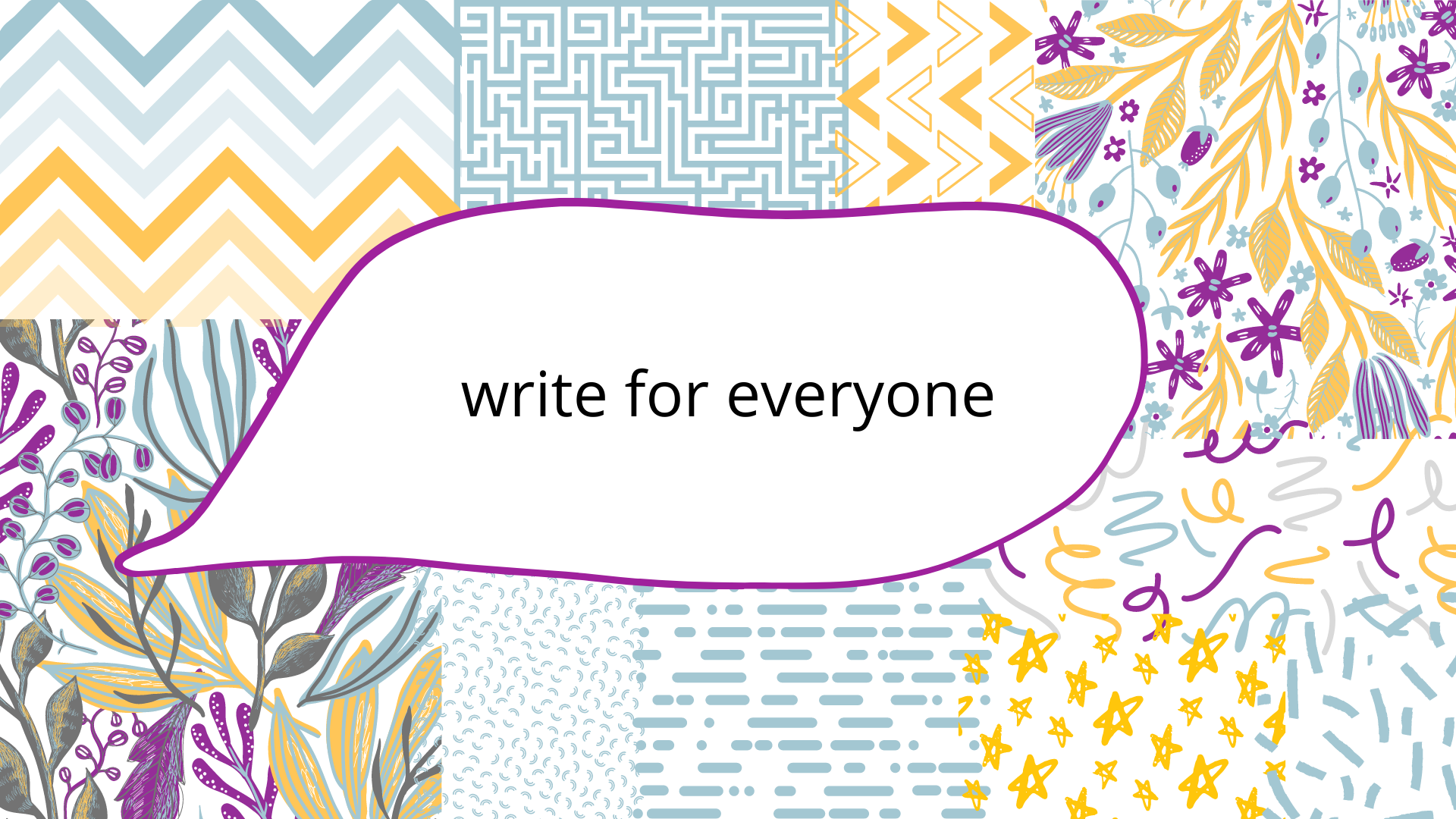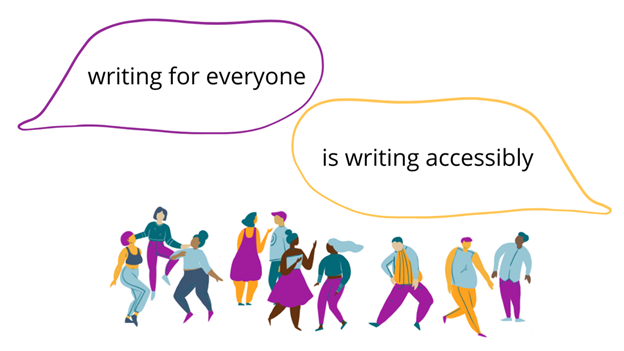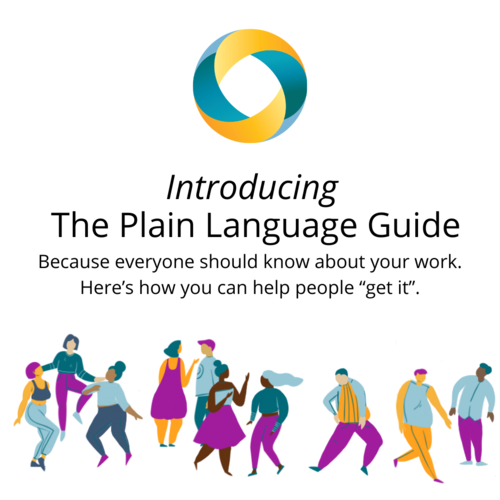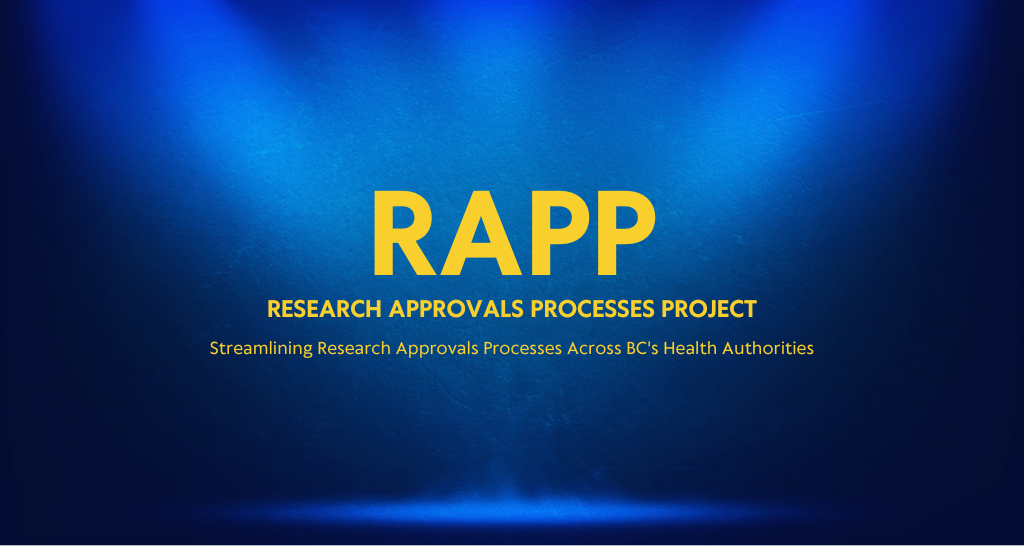4 reasons to write in plain language and why it’s easier than you think
21 April 2021

Image: a speech bubble that says “write for everyone” over a colourful, multi-pattern background.
Why are the Methods Clusters so interested in plain language?
Research – but especially methods research – can be particularly dry & technical – and critically, impenetrable to folks that aren’t doing the work themselves. We’ve seen how language plays a role in gate-keeping our diverse communities from understanding what’s happening in methods research, and we decided to do something about it.
There’s such great work that lays out why plain language is important. There’s a whole plain language movement that has erupted over the years that persuades that plain language is essential not only in health research, but in other key facets of our democratic life, i.e. law, government.
But that doesn’t make writing in plain language easier for people to adapt their styles, skills, words, sentence structure.
It’s kind of like the whole reason we’re doing methods research in the first place: we all understand and agree that patient-oriented research is important – but how we do it (patient-oriented research) is an important evidence gap that we felt needed to be bridged.

I’ve seen other tools about plain language…
There are several plain language resources out there, but many left us wanting. There might be a long list of ‘do’s and ‘don’ts’. There might be 200+ pages of not-very-plain-language text to read before you can go out and try it, essentially on your own.
We wanted to do better for our patient-oriented research teams; in fact, we felt we needed to do better for two main reasons:
- In the patient-oriented research environment, sharing understanding, and speaking each other’s language are necessary ingredients to working together well.
- We needed to understand the work too, for us to do our jobs disseminating the brilliant work being done to the audiences that need to hear about it.
If you’re not convinced that plain language is important, here are four reasons to change your mind:
1. Equitable use.

The first principle of Universal Design is equitable use. We apply this to patient-oriented research because patients deserve to understand work that is about them. We know that those with the highest risk for health issues have the lowest levels of health literacy. This makes it imperative we make our information accessible to a wide range of readers. Few of us know the technical jargon within health research, but we know what it feels like when it impacts care, and we should be able to participate in this work. For the people most impacted by our health system, we need to untangle our language to make research accessible.
2. Everyone appreciates simplicity.
![Image by Jonathan Soren Davidson for Disabled And Here. [link to: https://affecttheverb.com/gallery/disabledandhere/eveninglounge/] Image: three Black friends sit in comfortable chairs and supportive recliners during an evening conversation. Click through for more alt-text by the artist. [click through link: https://affecttheverb.com/gallery/disabledandhere/eveninglounge/]](https://healthresearchbc.ca/wp-content/uploads/2023/02/4_DisabledAndHere.jpg)
Image: three Black friends sit in comfortable chairs and supportive recliners during an evening conversation. Click through for more alt-text by the artist.
We’re not just writing for people who don’t have the same level of education we have. It’s not ‘dumbing it down’. Simplicity is beautiful. Clarity is kindness. Plain language is for people who are tired, stressed, or overworked; for those who have a different first language, and for the simply overwhelmed. By making our information easy for people to read, we make it easy to access. Who isn’t tired, stressed and overwhelmed right now?
3. Jargon is unpleasant.
You can make just about anything difficult to understand. For example, we could tell you that we want to learn fakie spine transfers. You probably have no clue what we’re talking about.
Well, put on your roller-skates, we’re hitting up the skate park! A fakie spine transfer is a move that has you going backwards, and jumping over a thin, steep section that divides two bowls.
So now, you might be thinking: “What’s a bowl?”
Roller skating is a niche sport, with niche tricks, terms, gear, etc. The trick name ‘fakie spine transfer’ might be helpful to people in the sport but for pretty much anyone else, a jargon-free description is a lot more useful.

Jargon is a huge barrier.
It’s not that people can’t understand what you’re doing when you use jargon – we can all Google. But why put people a Google-lengths away? Give people a chance to engage. Write in words everyone understands.
4. It doesn’t have to be hard.
Think of plain language like small talk, maybe it comes naturally, maybe it doesn’t. But everyone can do it, and can get better at it. And setting up the context to try it out can help! If you can talk about your work (or imagine talking about your work) with a barista, your mother, or a neighbour, you’ve got what it takes. You just need to write like how you’d talk to them.

Let us help! Click the picture below to try out our Plain Language Guide and let us know what you think.

Below the text, a colourful group of people chat and dance.
The Methods Clusters project studied the way that patient-oriented research is done, and how it could be better. In a series of blog posts, team members wrote about their work, what they learned and the best ways to engage patients in health research design. The BC SUPPORT Unit provided funding for the project.
This blog post was written by Amber Hui and Katie Verigin.





